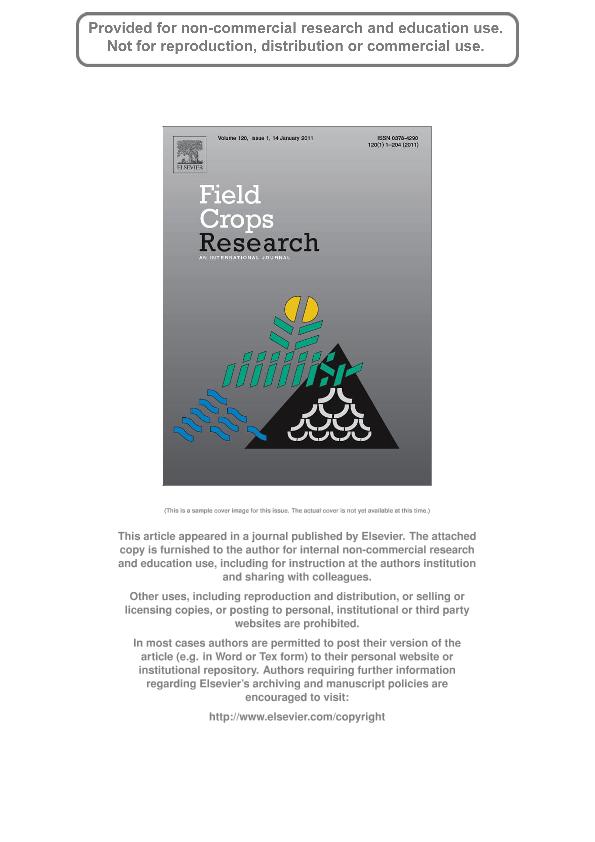Mostrar el registro sencillo del ítem
dc.contributor.author
Estrada Campuzano, Gaspar
dc.contributor.author
Slafer, Gustavo Ariel

dc.contributor.author
Miralles, Daniel Julio

dc.date.available
2017-05-23T19:44:53Z
dc.date.issued
2012-03
dc.identifier.citation
Estrada Campuzano, Gaspar; Slafer, Gustavo Ariel; Miralles, Daniel Julio; Differences in yield, biomass and their components between triticale and wheat grown under contrasting water and nitrogen environments; Elsevier Science; Field Crops Research; 128; 1; 3-2012; 167-179
dc.identifier.issn
0378-4290
dc.identifier.uri
http://hdl.handle.net/11336/16891
dc.description.abstract
A number of evidences have shown that triticale produces more above-ground dry matter (AGDM) than other winter cereals indry environments.AsAGDMaccumulated by crop before anthesishas beenpointed out as an important attribute under rainfed environments, the comparison of its physiological attributes (i.e. accumulated intercepted radiation – IPAR and radiation use efficiency – RUE), comparing among different cultivars and respect to other cereals, could be valuable to identify prospective traits to be used in breeding programs. Three experiments were carried out during the 2004 and 2005 growing seasons to (i) determine the effect of water stress on the yield and the eco-physiological components of biomass (i.e. accumulated intercepted radiation and RUE throughout the crop cycle) in a wide range of triticale cultivars to evaluate the genotypic variability (in interaction with water regime) for those traits and (ii) to analyze the causes for the commonly found differences in yield and AGDM between triticale and wheat under different water and nitrogen conditions. The triticale cultivars showed an important variability in yield and yield components sensitivity to drought. Water restrictions reduced AGDM, more than its partitioning to the reproductive organs, due to reductions in crop growth rate mainly through reduced RUE when different triticale cultivars were analyzed. Triticale outyielded wheat due to an increased biomass at anthesis and at maturity associated with higher RUE, probably due to a better light distribution into the canopy, more than by differences in IPAR. Triticale advantages were especially noticeable in the Mediterranean-type environment where yield and biomass were almosttwice than that of wheat, associated with differences of similar magnitude in RUE.
dc.format
application/pdf
dc.language.iso
eng
dc.publisher
Elsevier Science

dc.rights
info:eu-repo/semantics/openAccess
dc.rights.uri
https://creativecommons.org/licenses/by-nc-nd/2.5/ar/
dc.subject
Triticale
dc.subject
Biomass
dc.subject
Intercepted Radiation
dc.subject
Radiation Use Efficiency
dc.subject.classification
Agricultura

dc.subject.classification
Agricultura, Silvicultura y Pesca

dc.subject.classification
CIENCIAS AGRÍCOLAS

dc.title
Differences in yield, biomass and their components between triticale and wheat grown under contrasting water and nitrogen environments
dc.type
info:eu-repo/semantics/article
dc.type
info:ar-repo/semantics/artículo
dc.type
info:eu-repo/semantics/publishedVersion
dc.date.updated
2017-05-22T20:47:54Z
dc.journal.volume
128
dc.journal.number
1
dc.journal.pagination
167-179
dc.journal.pais
Países Bajos

dc.journal.ciudad
Amsterdam
dc.description.fil
Fil: Estrada Campuzano, Gaspar. Consejo Nacional de Investigaciones Científicas y Técnicas. Oficina de Coordinación Administrativa Parque Centenario. Instituto de Investigaciones Fisiológicas y Ecológicas Vinculadas a la Agricultura. Universidad de Buenos Aires. Facultad de Agronomía. Instituto de Investigaciones Fisiológicas y Ecológicas Vinculadas a la Agricultura; Argentina
dc.description.fil
Fil: Slafer, Gustavo Ariel. Institució Catalana de Recerca i Estudis Avancats; España. Consejo Nacional de Investigaciones Científicas y Técnicas; Argentina
dc.description.fil
Fil: Miralles, Daniel Julio. Consejo Nacional de Investigaciones Científicas y Técnicas. Oficina de Coordinación Administrativa Parque Centenario. Instituto de Investigaciones Fisiológicas y Ecológicas Vinculadas a la Agricultura. Universidad de Buenos Aires. Facultad de Agronomía. Instituto de Investigaciones Fisiológicas y Ecológicas Vinculadas a la Agricultura; Argentina
dc.journal.title
Field Crops Research

dc.relation.alternativeid
info:eu-repo/semantics/altIdentifier/doi/http://dx.doi.org/10.1016/j.fcr.2012.01.003
dc.relation.alternativeid
info:eu-repo/semantics/altIdentifier/url/http://www.sciencedirect.com/science/article/pii/S0378429012000056
Archivos asociados
